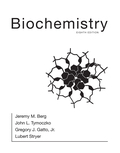
Concept explainers
Interpretation : The comparison between fermentation and respiration in terms of electron donors and electron acceptors needs to be explained.
Concept Introduction : An electron transport chain (ETC) is the series of
Answer to Problem 1P
In fermentation both, electron donors and acceptors are organic compounds. But in respiration, electron acceptor can be an inorganic molecule.
Explanation of Solution
Fermentation is the process of conversion of pyruvate into lactic acid or alcohol. This takes place in the absence of oxygen only. During the process of fermentation, pyruvate is the electron acceptor and NADH is the electron donor. This means, in fermentation, the organic compound acts as both electron donor and electron acceptor.
During the process of respiration, oxygen is present. In this process, NADH acts as the electron donor and oxygen is the final electron acceptor. So, in this process, the electron donor is an organic molecule, while an electron acceptor is an inorganic molecule.
In fermentation both, electron donors and acceptors are organic compounds. But in respiration, electron acceptor can be an inorganic molecule.
Want to see more full solutions like this?
Chapter 18 Solutions
EBK BIOCHEMISTRY
- A violation of the First Law? The complete combustion of glucose to CO 2 and H 2 O yields 30 ATP, as shown in Table 18.4 . However, the synthesis of glucose requires only 18 ATP. How is it possible that glucose synthesis from CO 2 and H 2 O requires only 18 ATP , but combustion to CO 2 and H 2 O yields 30 ATP? Is it a violation of the First Law of Thermodynamics , or perhaps a miracle?arrow_forwardPredict the relative amount of energy released for each of the common terminal electron acceptors used during anaerobic respiration, as compared to energy released during aerobic respirationarrow_forwardA1 Calculate the ATP yield for the complete oxidation of oleate.arrow_forward
- (Biochemsitry, Topics: Glycolysis and Citric Acid Cycle) - How many ATP are formed from the complete oxidation of fructose in the liver?arrow_forwardWhy bother to eat? What are the three primary uses for cellular energy?arrow_forwardCalculate the atp yeild from complete oxidation of the following molecules by the reaction of glycolysis citric acid cycle, electron transport chain and oxidative phosphorylation. Maltose Fructose Secrotose .arrow_forward
- 20. A hoax, perhaps? The citric acid cycle is part of aero-bic respiration, but no O 2 is required for the cycle. Explainthis paradox.arrow_forward33. Explain the point of organisms having fermentation when aerobic respiration provides an efficient way of producing ATP?arrow_forward6. Cycle of tricarboxylic acids (TCA):• importance for cellular metabolism;• intracellular localization of TCA enzymes;• sequence of TCA reactions;• TCA enzymes and coenzymes;• substrate phosphorylation reactions in TCA;• decarboxylation reactions in TCA;• enzymes and coenzymes in dihydrogen reactions in TCA;• mechanisms of regulation of TCA.arrow_forward

 BiochemistryBiochemistryISBN:9781305577206Author:Reginald H. Garrett, Charles M. GrishamPublisher:Cengage Learning
BiochemistryBiochemistryISBN:9781305577206Author:Reginald H. Garrett, Charles M. GrishamPublisher:Cengage Learning

